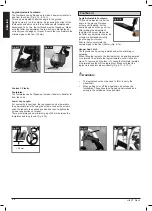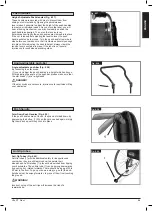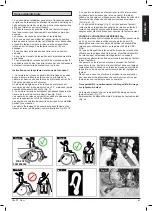
ENGLISH
31
Life RT Rev.J
Fig. 6.46
The lap belt should be fixed so that the belt sits at an angle of 45
degrees across the user’s pelvis. The user should be upright
and be as far back as possible in the seat when correctly
adjusted. The lap belt should not allow the user to slip down in
the seat.
(Fig. 6.47)
To fasten buckle:
Firmly push male buckle
into female buckle.
To release belt:
Press exposed sides of male
buckle and push towards
centre whilst gently pulling
apart.
WARNING!
•
If in doubt about the use and operation of the lap belt then
ask your healthcare professional, wheelchair dealer, carer
or attendant for assistance.
•
If you want to retrofit a lap belt, then please contact your
authorised Sunrise Medical dealer.
•
The lap belt must be checked on a daily basis to ensure it
is adjusted correctly and free from any obstruction or
adverse wear.
•
Sunrise Medical does not encourage the transportation of
any person in a vehicle using this lap belt as a method of
restraint.
Please see Sunrise Medical transit booklet for further
advice on transportation.
Fig. 6.47
Maintenance:
Check lap belt and securing components at regular intervals for
any sign of fraying or damage. Replace if necessary.
WARNING
The lap belt should be adjusted to suit the end user as detailed
above. Sunrise Medical recommends that the length and fit of
the belt be checked on a regular basis to reduce the risk of the
end user inadvertently re-adjusting the belt to an excessive
length.
Transit Wheels (Fig. 6.48)
Transit wheels should be used wherever your wheelchair would
be too wide if the rear wheels were used. After the rear wheels
have been removed with the aid of the quick-release axles, the
transit wheels can immediately be used to continue riding. The
transit wheels are mounted so that they are approx. 3
centimeters above the ground when not in use. They are thus
out of the way when riding, transporting, or when tipping to pass
over obstacles.
CAUTION!
Without rear wheels, your wheelchair has no wheel locks.
Transit Wheels
Fig. 6.48
7.0 Tyres and mounting
Solid rubber tyres are standard.
With pneumatic tyres always make sure that the tyres have the
correct air pressure, as otherwise the performance of the
wheelchair may be affected. If the tyre pressure is too low,
rolling resistance will increase, requiring more effort to move the
chair forward. Low tyre pressure also has a negative impact on
maneuverability. If the tyre pressure is too high, the tyre could
burst. The correct pressure for a given tyre is printed on the
surface of the tyre itself.
Tyres can be mounted the same way as an ordinary bicycle
tyre. Before installing a new inner tube, you should always
make sure that the base of the rim and the interior of the tyre
are free of foreign objects. Check the pressure after mounting
or repairing a tyre. It is critical to your safety and to the
wheelchair’s performance that regulation air pressure be
maintained and that tyres are in good condition.






























